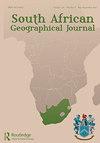测量和解释风向的问题
IF 1.4
4区 社会学
Q3 GEOGRAPHY
引用次数: 0
摘要
本研究强调了一个重要的方法论和实践问题,涉及在野外风成学研究中使用磁罗盘。根据地理位置的不同,地磁偏角可以显著影响风速计对风向的野外测量,以及对沙丘等地貌特征方向的测量。因此,令人惊讶的是,对已发表的风沙研究的方法学描述,包括在南部非洲的研究,往往忽略了对任何应用于实地测量或仪器记录的赤纬校正的描述。这导致在这些研究中报告的数据的有效性不确定,特别是在实际风向可能与测量值非常不同(在某些情况下大于20°)的情况下。本研究以非洲南部和全球其他关键地区的文献为例,讨论了在测量和报告风向时,特别是在使用或整合来自不同来源的风数据集,或在比较已发表的研究时,需要更明确地应用赤纬校正。本文章由计算机程序翻译,如有差异,请以英文原文为准。
Issues of measuring and interpreting wind direction
ABSTRACT This study highlights a significant methodological and practical issue involving the use of a magnetic compass in aeolian studies in the field. Geomagnetic declination can significantly affect field measurements of wind direction from anemometers as well as measurement of the orientation of geomorphic features such as sand dunes, depending on geographic location. It is therefore surprising how often methodological descriptions of published aeolian studies, including those in southern Africa, neglect to describe any declination corrections applied to field measurements or instrumental records. This results in uncertainty in the validity of data reported in such studies, particularly where actual wind directions may be very different (>20° in some cases) from measured values. Drawing from examples in the literature from southern Africa and other key locations globally, this study discusses the need for greater clarity in the declination corrections applied when wind direction is being measured and reported, especially where wind datasets from different sources are being used or integrated, or when published studies are being compared.
求助全文
通过发布文献求助,成功后即可免费获取论文全文。
去求助
来源期刊

South African Geographical Journal
GEOGRAPHY-
CiteScore
3.40
自引率
7.10%
发文量
25
期刊介绍:
The South African Geographical Journal was founded in 1917 and is the flagship journal of the Society of South African Geographers. The journal aims at using southern Africa as a region from, and through, which to communicate geographic knowledge and to engage with issues and themes relevant to the discipline. The journal is a forum for papers of a high academic quality and welcomes papers dealing with philosophical and methodological issues and topics of an international scope that are significant for the region and the African continent, including: Climate change Environmental studies Development Governance and policy Physical and urban Geography Human Geography Sustainability Tourism GIS and remote sensing
 求助内容:
求助内容: 应助结果提醒方式:
应助结果提醒方式:


